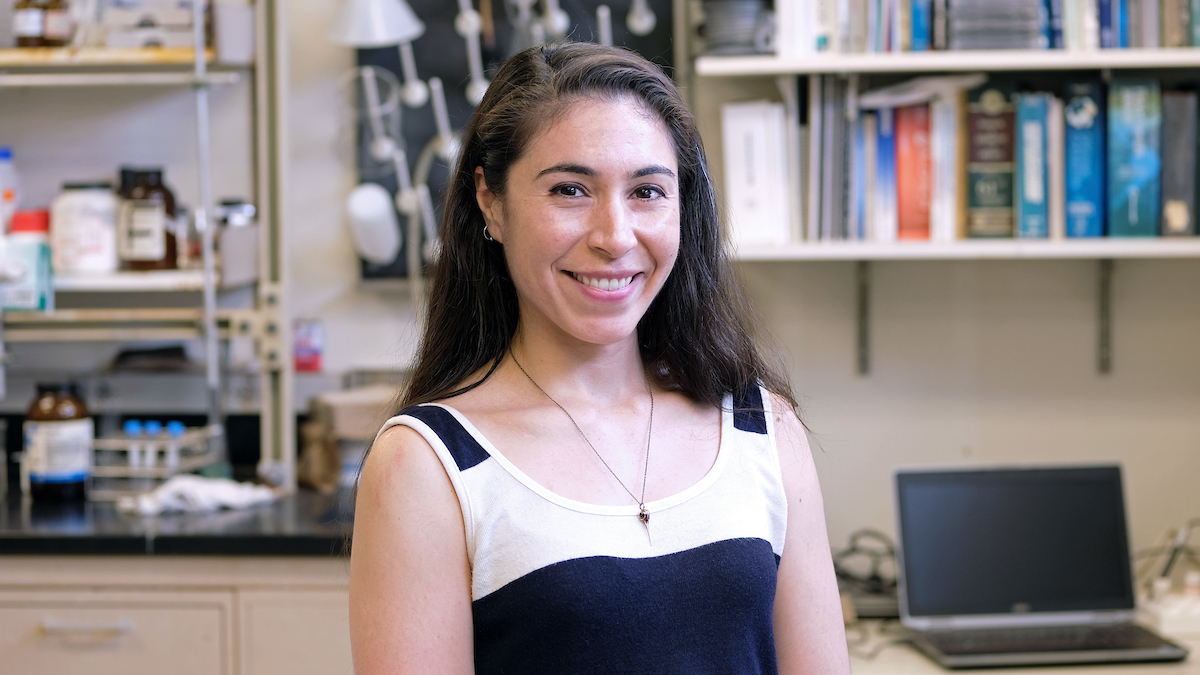
Chemistry graduate Lorna Espinosa enrolled in Bruce Hamper’s beer-brewing class looking for a break from physical chemistry. But it helped open doors to an internship at Urban Chestnut Brewing Company, undergraduate research experience analyzing beer bitterness and a potential future career. (Photo by August Jennewein)
Lorna Espinosa will be spending some time at Urban Chestnut Brewing Company after commencement – and not just for a celebratory beer.
The pending graduate in the Department of Chemistry and Biochemistry at the University of Missouri–St. Louis has a four-week internship lined up with the local craft brewery, working in its quality assurance laboratory. It will be a continuation of work Espinosa did last year under the supervision of quality assurance manager Kurt Driesner.
For six weeks last summer, she’d arrive at the company’s Grove Brewery and Bierhall, put on her lab coat, pick up her clipboard and get to work.
“I would go around the facilities making sure that temperatures were right on, that the pressures were right on in the boiler, the glycol coolers were working,” Espinosa said. “I would take samples of beers that were still undergoing the fermentation process, and I would do a yeast cell count. I would check pH. I would check the gravity, which is the density of the sugar content. Based on the change in sugars from day to day, you could monitor the yeast activity – how much they’re converting sugar to alcohol – and you can predict what the final alcohol content will be.”
Scientific methods have always been part of the brewing process, but Urban Chestnut is one of the craft brewers that employs scientific analysis in a constant quest to perfect its product.
One reason is pragmatic. To succeed selling its beer in stores spread around six states, it has to make sure each batch of a particular beer is consistent and will keep when transported over great distances.
But Urban Chestnut’s commitment to the science of beer-making goes even further.
“Kurt Driesner and Florian Kuplent, the owner, have laid out in the past a desire to publish something in a scientific brewer’s journal every year,” Espinosa said.
That appealed to her.
A native of Los Angeles, Espinosa came to UMSL looking to reinvent herself in 2014 after moving to St. Louis from Phoenix when her husband accepted a job as an electrical engineer at Boeing.
She already owned one bachelor’s degree in art history from Smith College, but she decided this time to study chemistry, inspired at least in part by her interest in baking and the science of what goes on in the mixing bowl or oven.
She was more than a year into the program and already had done some research under Professor James Chickos when she made the decision to enroll in Assistant Teaching Professor Bruce Hamper’s Chemistry 1021 course “Beer Brewing: Chemical and Biochemical Principles” in the fall of 2016.
“I landed in Dr. Hamper’s beer class just purely because I wanted to take a break, as it were, from the heavier scientific classes,” Espinosa said recently. “I’ve always enjoyed beer, and I thought it would be a fun thing to do twice a week.”
She had no idea the direction it would lead her.
The course covers the basics of the chemical and biochemical processes involved in brewing – enough to prepare interested students in doing their own home-brewing. It also has students observe at local brewers around town – everywhere from beer giant Anheuser-Busch to much smaller operations such as Ferguson Brewing Company.
“She took it on Thursday evenings with us,” Hamper said, “and I had more science majors and people with brilliant experience, so I upped the game a little bit on what we did. She did a really wonderful job of carrying out the lab exercises, and with her chemistry background and being a science major, she was able to partner with other students that were, say, business majors and really help them out. In that way, she served as an extra TA. Whether she knew it or not, that’s the kind of talent that she brought.”
That explains why she was among the students Hamper recommended for the internship at Urban Chestnut last summer, and Espinosa impressed enough on her interview to land the position.
She’s been back at work with Hamper this semester examining hops flavorings in beer while earning research credit toward her degree. They’ve been using high-performance liquid chromatography to measure the level of isohumulones, the chemical compounds that account for the bitter taste in beer.
Hamper’s team has developed a relatively fast analytical technique involving HPLC that gives a more accurate reading on the amount of isohumulones than the ultraviolet-visible spectroscopy method that most American brewers have been using to determine a beer’s bitterness – measured on the International Bitterness Units scale – since the 1950s and 1960s.
The UV-vis method might have worked fine for the standard American lagers that dominated the beer market for decades, but it has proved less reliable for measuring the wide range of styles – with their varied ingredients – produced by craft brewers.
With Espinosa’s connections at Urban Chestnut, she was able to go behind the bar with a rack of centrifuge tubes and fill 25 of them with samples she brought back to campus. The team tested all 25 in an afternoon with a test that took only five minutes per sample.
“That’s unheard of, even in the brewing industry,” Hamper said. “I think we’ll need to do a little bit more work on it, but in the future, we’ll probably publish those results, and Lorna will be one of the contributors in that publication.”
Espinosa already presented some of her findings last month at the Undergraduate Research Symposium.
Now, she’s getting set to launch her career. Her training at UMSL – both in chromatography and ultraviolet-visible spectroscopy – would make her well-suited to work in many different kinds of labs.
“I really enjoy being on my feet, working with my hands, seeing the results,” she said. “It’s really exciting to have been working nose to the grindstone for a week and then finally see a graphic that kind of pulls it all together. It’s a very satisfying sense of accomplishment, and I really enjoy the setting and the type of person that’s drawn to a laboratory job. I can see myself alongside all sorts of people like that.”
Hamper believes her experience has her well-positioned for opportunities within the competitive beer industry.
“I think she’s going to be happily surprised when she sees what happens when she goes out there,” Hamper said. “She has the internship with Urban Chestnut. She’s carried out research in the area, and she completed the course at UMSL. It’d be hard to find a candidate with those three items under their belt, particularly the research piece. I think those three points will be to her advantage in looking for jobs.”














